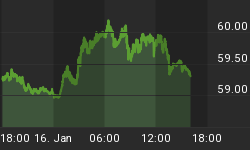Wednesday was another in a string of boring days - welcome boring days, given that Old Man Winter seems finally to be loosing his icy grip - with stocks rallying again (+0.5%). The quiet is certainly helping stocks, and assuming the S&P can break through the January highs around 1150 it looks like a fairly easy cruise to 1175 merely on technical momentum (that level is the ultimate target of that inverted head-and-shoulders pattern, and also roughly the projection off the Nov and Jan highs). After that, though, I am increasingly skeptical. The low levels of risk aversion admit of two potential outcomes: a slow and painful grind higher, or a sharp and painful trade lower. Either way, painful.
The 10y note contract today weakened 6 ticks, with the 10y yield moving back to 3.72%. The market was a little weaker than that prior to the 10y auction bidding deadline - in quiet markets, the concession for supply is more obvious. After the auction, which went fine, prices recovered somewhat.
Tomorrow brings some data, finally, with Initial Claims due (Consensus: 460k). Recall that Claims recently had been rising but dipped last week to 469k. The economist consensus of 460k is simply saying that the recent rise we have seen in Claims is false and we ought to be improving once again. Frankly, it is a little wishy-washy given all that I have been reading about how Payrolls ought to be zooming next month. If we're growing at 200-350k new jobs per month, Initial Claims shouldn't be here (see Chart, source BLS and Labor Department). Red marks the Feb Employment Report and the last 'Claims figure.

Which is it? Are Payrolls going up or are Claims staying around here?
If Payrolls are running at 250k, we should be seeing 335k or so in Claims, about 135k/week better than we are actually seeing. If we generously assume that 100k of the Payrolls forecast is "make-up" for the February weather, then the trend would suggest around 360k new Claims per week to equate to 150k net new jobs per month. Even the upper end of the cloud near x=150k is y=375k-400k. If we ignore the Census jobs (although these data include two prior censuses), and say they are expected to add 50k...well, you get the idea: you have to make a bunch of assumptions, all of them on the generous side, to square Initial Claims of 460,000 with a 250,000 rise in Payrolls for the month. That isn't saying it can't happen, but we ought to be skeptical of what the economists suddenly seem so sure of: the next Payrolls report will be a huge gain.
By the way, the regression line I've drawn is linear, but you can see that Claims tend to be floored near 300,000; a more-accurate estimator would be nonlinear and would tend to make the current point more of an outlier. It doesn't make a huge difference, though, and you get the point.
On an unrelated note: Ellyn Terry at the Atlanta Fed has posted an insightful commentary on the Atlanta Fed macroblog. She analyzes consumer credit and credit availability and finds that while the overall trends in consumer credit recently seem to be similar to prior recessions (except for the 2001 "recession," in which consumer credit never even skipped a beat)...
"...once the current recession is separated into revolving and nonrevolving credit, the relationship to past recessions changes. Typically in a recession, nonrevolving credit shrinks considerably while revolving credit shrinks little if at all. The trend so far in this recession has been the exact opposite; nonrevolving credit essentially has remained unchanged while revolving credit has shrunk 11 percent."
I think it's a pretty interesting observation. Are people cutting up their credit cards and swearing off credit, or are banks not giving a new card to anyone with a pulse any more? You can read the full article, in which she goes on to examine whether the difference is on the credit demand or the credit supply side, here.
On Friday, economists expect roughly flat Retail Sales and Michigan Sentiment, once again at odds with the rising speculation about boffo Payrolls. I mention it today because I won't be posting tomorrow as I will be traveling on business.
















